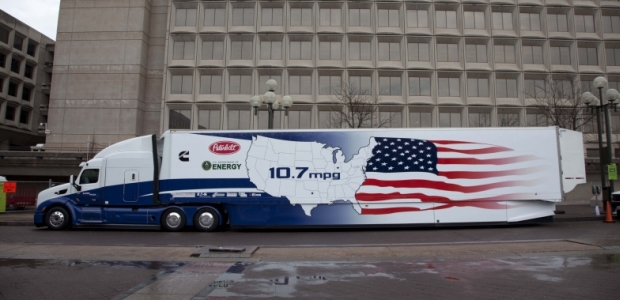
SuperTruck II Goals Announced
DoE said SuperTruck II projects will research, develop, and demonstrate technologies to improve heavy-truck freight efficiency by more than 100 percent when compared with a manufacturer's best-in-class 2009 truck, with an emphasis on technology cost-effectiveness and performance.
The U.S. Department of Energy's SuperTruck initiative moved into a new phase March 1 when Deputy Assistant Secretary for Transportation Reuben Sarkar announced SuperTruck II, an $80 million funding opportunity (subject to congressional appropriations) for research, development, and demonstration of long-haul tractor-trailer truck technology and more than $12 million in selections for three new cost-shared projects focused on the research, development, and demonstration of plug-in electric powertrain technologies for medium- and heavy-duty vehicles. "Improving the efficiency of commercial trucks is critical to reducing our petroleum consumption, strengthening our clean-energy economy, and further reducing our contributions to climate change," Sarkar said. "This new funding will not only accelerate innovation but also foster rapid market adoption of new energy-efficient vehicle technologies."
DoE launched the SuperTruck initiative in 2010. The goal: develop tractor-trailers that are 50 percent more efficient than baseline models by 2015. And trucks made by Cummins and Peterbilt exceeded this goal, demonstrating a 20 percent gain in engine efficiency and a 70 percent increase in freight efficiency while surpassing 10 miles per gallon under real-world driving conditions, compared with an average Class 8 truck's typical 5.8 miles to the gallon, according to the department.
This type of truck hauls 70 percent of all U.S. freight tonnage.
DoE said SuperTruck II projects will research, develop, and demonstrate technologies to improve heavy-truck freight efficiency by more than 100 percent when compared with a manufacturer's best-in-class 2009 truck, with an emphasis on technology cost-effectiveness and performance. "Achieving Class 8 truck efficiency increases will require an integrated systems approach to ensure that the various components of the vehicle work together. SuperTruck II projects will utilize a wide variety of truck and trailer technology approaches to achieve performance targets, such as improvements in engine efficiency, drivetrain efficiency, aerodynamic drag, tire rolling resistance, and vehicle weight," according to the agency, which said the recipients of the funding for plug-in electric powertrain technologies for medium and heavy-duty vehicles are:
- Robert Bosch LLC (Farmington Hills, Mich.) will receive $5 million to develop and demonstrate a medium-duty plug in hybrid vehicle powertrain that reduces fuel consumption by 50 percent.
- Cummins Corporate Research and Technology (Columbus, Ind.) will receive $4.5 million to develop and demonstrate a Class 6 plug-in hybrid delivery truck that reduces fuel consumption by 50 percent.
- McLaren Performance Technologies (Livonia, Mich.) will receive $2.6 million to develop a Class 6 delivery truck with a scalable, innovative, lightweight, low-cost, and commercially-viable plug-in electric drive system that improves fuel economy by 100 percent.